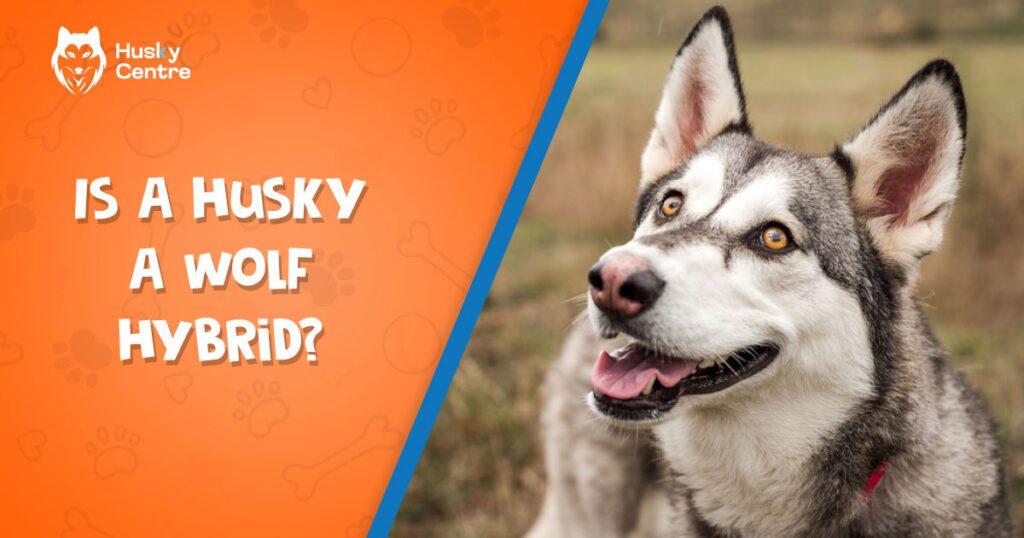No, a Husky is not a wolf hybrid. Huskies are domesticated dogs, distinct from wolves, though they share some physical traits.
Huskies, known for their striking blue eyes and thick fur, are a popular dog breed. These dogs originated in Siberia, bred by the Chukchi people for sledding and companionship. They possess a friendly, energetic nature, making them great family pets.
Despite their wolf-like appearance, they are fully domesticated and have no direct wolf lineage. Their intelligence and endurance make them suitable for various activities, from pulling sleds to participating in dog sports. Understanding the distinction between Huskies and wolf hybrids is essential for potential owners. Huskies require consistent training and socialization to thrive in a home environment.
Differences Between Huskies And Wolves
Many people often wonder if a Husky is a wolf hybrid. While Huskies and wolves may look alike, they have many differences.
Knowing these differences can help you understand both animals better. Let’s explore the key differences between Huskies and wolves under the following subheadings.
Genetic Distinctions
Despite their similar looks, Huskies and wolves have different genetic makeups. Wolves are wild animals, while Huskies are domesticated dogs. Scientists use genetic testing to identify these differences.
Key genetic distinctions include:
- Wolves have 78 chromosomes, while Huskies have 78 too, but arranged differently.
- Wolves have unique genetic markers that differ from those in Huskies.
- Huskies have genes that make them more social and trainable.
Huskies are also bred for specific traits like friendliness and loyalty. These traits are not common in wolves.
Genetic studies show that Huskies have been domesticated for thousands of years. This long history of domestication separates them from wolves on a genetic level.
Physical Characteristics
At first glance, Huskies and wolves may look similar. But there are clear physical differences between them.
Notable physical differences include:
- Wolves are generally larger and have longer legs than Huskies.
- Huskies have a wider variety of coat colors and patterns.
- Wolves have a more muscular build and larger paws.
A table comparing their physical characteristics:
| Characteristic | Husky | Wolf |
| Size | Medium | Large |
| Leg Length | Shorter | Longer |
| Coat Color | Various | Gray, White, Black |
Huskies also have facial markings that are unique to their breed. Wolves have a more uniform coat color. These physical traits make it easier to tell them apart.
Behavioral Differences
Behavior is another area where Huskies and wolves differ greatly. Huskies are known for their playful and friendly nature. Wolves are more reserved and cautious.
Key behavioral differences include:
- Huskies are more social and enjoy human company.
- Wolves are shy and prefer to stay away from humans.
- Huskies can be trained easily, while wolves cannot.
Huskies also get along well with other pets. Wolves are more territorial and may not tolerate other animals. Huskies love to play and are very energetic. Wolves are more focused on survival and hunting.
Understanding these behavioral traits can help you see why Huskies are great pets. Wolves, on the other hand, are better left in the wild.
The Origins Of The Siberian Husky
The Siberian Husky is often mistaken for a wolf hybrid due to its striking resemblance to its wild cousins. To understand the origins of the Siberian Husky, we need to delve into its fascinating history and the significant roles it has played over the centuries.
Breed History
The Siberian Husky traces its roots back to the Chukchi people of Siberia. The Chukchi bred these dogs over 3,000 years ago. They needed a reliable means of transportation across vast icy terrains.
Some key points about the breed’s history include:
- The Chukchi people bred Huskies for endurance, not speed.
- Huskies were essential for hunting and survival in harsh climates.
- The breed was introduced to North America in the early 20th century.
A significant milestone in the breed’s history was the 1925 serum run to Nome. This event showcased the Huskies’ incredible stamina and resilience.
The serum run involved a relay of dog sled teams that delivered diphtheria antitoxin across Alaska, saving countless lives.
Here’s a brief timeline:
| Year | Event |
| 3000 BC | Chukchi people begin breeding Huskies |
| 1909 | First Huskies arrive in Alaska |
| 1925 | Serum run to Nome |
Role As A Working Dog
The Siberian Husky has always been a working dog. Its primary role was pulling sleds across icy landscapes. Huskies were essential for transportation and communication in remote Siberian regions.
Some of the tasks Huskies performed include:
- Pulling sleds loaded with supplies
- Helping in hunting expeditions
- Assisting in search and rescue operations
Huskies are known for their remarkable endurance. They can travel long distances with minimal food. This made them perfect for the harsh conditions of the Arctic.
Today, Huskies still excel in various working roles:
- Sled racing: Huskies compete in races like the Iditarod.
- Search and rescue: Their keen sense of smell and stamina are invaluable.
- Therapy dogs: Their gentle nature makes them excellent companions.
The breed’s versatility and resilience have ensured its place as one of the most admired working dogs in the world.
Why Huskies Are Often Mistaken For Wolves
Many people often wonder if a Husky is a wolf hybrid. This confusion arises because Huskies share many similarities with wolves. Let’s explore the reasons why Huskies are often mistaken for wolves.
Appearance
Huskies have a striking resemblance to wolves, which often leads to confusion. They both have a similar body structure and facial features. Here are some common traits:
- Thick fur coats: Both Huskies and wolves have thick fur coats that help them survive in cold climates.
- Pointed ears: Their ears are erect and pointed, adding to their wolf-like appearance.
- Almond-shaped eyes: Both breeds have almond-shaped eyes, which can be blue, brown, or even a mix of both.
- Facial markings: Huskies often have facial markings that resemble those of wolves.
Here’s a comparison table to highlight these similarities:
| Feature | Husky | Wolf |
| Fur Coat | Thick, double-layered | Thick, double-layered |
| Ears | Pointed, erect | Pointed, erect |
| Eyes | Almond-shaped, various colors | Almond-shaped, yellow or amber |
| Facial Markings | Distinct, wolf-like | Natural camouflage |
Media And Popular Culture
Huskies are often featured in media and popular culture, enhancing their wolf-like image. Movies, TV shows, and books frequently portray Huskies in roles associated with wilderness and adventure. Here are a few examples:
- Movies: Films like “Balto” and “Snow Dogs” feature Huskies as main characters.
- TV shows: Huskies appear in shows like “Game of Thrones,” adding to their wild and majestic image.
- Books: Stories such as “The Call of the Wild” often describe Huskies in a wolf-like manner.
These portrayals influence public perception, making people think Huskies are closely related to wolves. Additionally, social media platforms feature countless photos and videos of Huskies, often emphasizing their resemblance to wolves. This further cements the idea that Huskies could be wolf hybrids.
Here are some key reasons why media impacts this perception:
- Visual Representation: Huskies are visually similar to wolves, and media often highlights these traits.
- Storyline Themes: Adventure and wilderness themes often include Huskies, reinforcing their wild image.
- Character Roles: Huskies are often cast in roles that require strength and resilience, traits associated with wolves.
These factors combined make it easy to see why people might mistake Huskies for wolf hybrids.
The Truth About Wolf Hybrids
When people see a Husky, they often wonder if it’s part wolf. The striking resemblance can confuse many. This blog post explores the truth about wolf hybrids. We’ll dive into what wolf hybrids are and the legal and ethical concerns around them.
What Are Wolf Hybrids
Wolf hybrids, also known as wolf-dog hybrids, are the result of mating a domestic dog with a wild wolf. These animals possess characteristics of both species. They can look very similar to wolves, but they also have traits of domestic dogs.
- Physical Appearance: They often have a wolf-like appearance, with a larger head, longer legs, and a more muscular build.
- Behavior: Their behavior can vary widely. Some may act like domestic dogs, while others may have wild, unpredictable tendencies.
- Intelligence: Wolf hybrids are usually very smart. They can learn commands but may not always follow them.
| Feature | Husky | Wolf Hybrid |
| Appearance | Friendly, approachable | Wild, intimidating |
| Behavior | Playful, loyal | Unpredictable, aggressive |
| Training | Easy to train | Challenging to train |
Legal And Ethical Considerations
Owning a wolf hybrid can be legally complicated. Laws vary widely from one place to another. Some areas completely ban wolf hybrids, while others have strict regulations.
- Licensing: Many regions require special licenses to own a wolf hybrid.
- Insurance: Some insurance companies may not cover homes with wolf hybrids.
- Fencing: Owners may need to have special fencing to contain these animals.
Ethical considerations are also crucial. Wolf hybrids can pose a danger to humans and other animals. They may not be suitable for families with children. These animals have complex needs that many owners can’t meet. They require large spaces, special diets, and a lot of mental stimulation.
- Is it fair to the animal? Mixing wild and domestic traits can create confused and stressed animals.
- Is it safe for the community? Wolf hybrids can be unpredictable and may pose risks.
- Can you meet their needs? These animals are not like regular dogs and need specific care.
Understanding the truth about wolf hybrids is essential. They are not just exotic pets. They come with significant responsibilities and risks.
Frequently Asked Questions
Is A Husky Related To A Wolf?
Yes, a husky is related to a wolf. Both belong to the Canidae family and share common ancestors.
How Do You Tell If Your Husky Is A Wolf Hybrid?
Check physical traits like size, coat, and eye color. DNA testing can confirm wolf hybrid status. Consult experts for accurate identification.
What Dog Is Closest To A Wolf?
The dog breed closest to a wolf is the Siberian Husky. They share many physical traits and genetic similarities. Another close breed is the Alaskan Malamute. Both breeds exhibit wolf-like behavior and appearance.
Is A Husky A Hybrid?
No, a husky is not a hybrid. It is a purebred dog, specifically a Siberian Husky.
Conclusion
Huskies and wolves may share similarities, but they are distinct species. Huskies are domesticated dogs, not wolf hybrids. Understanding their differences helps in proper care. Always research and consult experts for accurate information. This ensures a happy, healthy life for your Husky.
Stay informed and enjoy your loyal companion.


Meet Jarred, the heart and soul behind HukyCentre. With a deep affection for furry friends, he pours his passion into every word he writes. His genuine love for dogs shines through in his engaging and informative content. As a dedicated dog enthusiast, Jarred’s goal is to share valuable insights and tips that resonate with fellow dog lovers. Join Jarred on the journey as he celebrates the joy and companionship that dogs bring into our lives.



